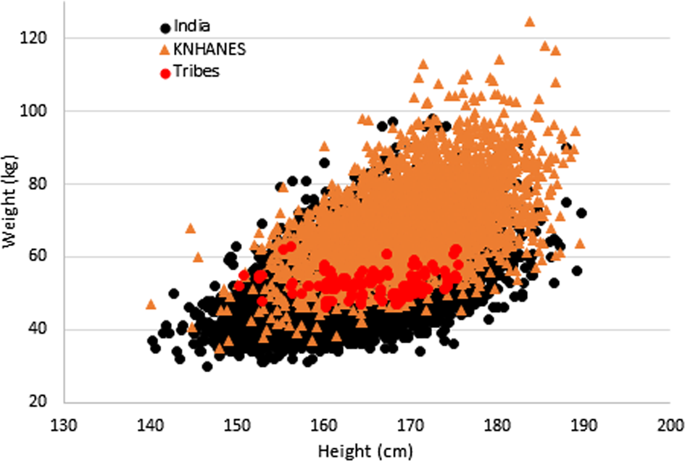Nutrition & Diabetes ( IF 6.1 ) Pub Date : 2019-01-09 , DOI: 10.1038/s41387-018-0068-3 Karoline Hood 1 , Jacob Ashcraft 1 , Krista Watts 1 , Sangmo Hong 2 , Woong Choi 2 , Steven B Heymsfield 3 , Rajesh K Gautam 4 , Diana Thomas 1

|
Background
Body mass index (BMI) represents a normalization of weight to height and is used to classify adiposity. While the capacity of BMI as an adiposity index has been experimentally validated in Caucasians, but there has been little testing Asian populations.
Methods
To determine whether weight scales to height squared in Asian Indians across the general population and in Asian Indian tribes an allometric analysis on the power law model, W = αHβ, where W is weight (kg) and H is height (m) was performed on cross-sectional weight and height data from India (N = 43,880) collected through the Anthropological Survey of India. The database contained males 18–84 years of age spanning 161 districts of 14 states and including 33 different tribes (N = 5,549). Models were developed that were unadjusted and adjusted for tribe membership. The Korean National Health and Nutrition Examination Survey (KNHANES) was used to compare to height–weight data from the Anthropological Survey of India and to calculate BMI thresholds for obesity status using a receiver operating characteristic.
Results
The unadjusted power was β = 2.08 (s = 0.02). The power for the general population (non-tribal) was β = 2.11 (s = 0.02). Powers when adjusted for tribe ranged from 1.87 to 2.35 with 24 of the 33 tribes resulting in statistically significant (p < 0.05) differences in powers from the general population. The coefficients of the adjusted terms ranged from −0.22 to 0.26 and therefore the scaling exponent does not deviate far from 2. Thresholds for BMI classification of overweight in the KNHANES database were BMI = 21 kg/m2 (AUC = 0.89) for males 18 kg/m2 (AUC = 0.97) for females. Obesity classification was calculated as BMI = 26 kg/m2 (AUC = 0.81) and 23 kg/m2 (AUC = 0.83) for females.
Conclusions
Our study confirms that weight scales to height squared in Asian Indian males even after adjusting for tribe membership. We also demonstrate that optimal BMI thresholds are lower in a Korean population in comparison to currently used BMI thresholds. These results support the application of BMI in Asian populations with potentially lower thresholds.
中文翻译:

两个亚洲人群的体重与身高的异速生长以及由此产生的体重指数阈值
背景
体重指数 (BMI) 代表体重与身高的标准化,用于对肥胖进行分类。虽然BMI作为肥胖指数的能力已经在白种人中得到了实验验证,但对亚洲人群的测试却很少。
方法
为了确定整个亚洲印第安人和亚洲印第安部落的体重是否与身高平方成正比,对幂律模型W = αH β进行了异速生长分析,其中 W 是体重 (kg),H 是身高 (m)基于 通过印度人类学调查收集的印度横截面体重和身高数据(N = 43,880)。该数据库包含 18-84 岁的男性,涵盖 14 个州的 161 个地区,包括 33 个不同的部落 ( N = 5,549)。开发的模型未根据部落成员身份进行调整和调整。韩国国家健康和营养检查调查 (KNHANES) 用于与印度人类学调查的身高体重数据进行比较,并使用接收者操作特征计算肥胖状态的 BMI 阈值。
结果
未调整的功效为β = 2.08 ( s = 0.02)。一般人群(非部落)的权力为β = 2.11 ( s = 0.02)。 按部落调整后的权力范围为 1.87 至 2.35,其中 33 个部落中有 24 个部落的权力与一般人群存在统计显着性 ( p < 0.05) 差异。调整项的系数范围为 -0.22 至 0.26,因此标度指数不会偏离 2 太远。KNHANES 数据库中体重指数超重分类的阈值是男性 BMI = 21 kg/m 2 (AUC = 0.89 ) 18 kg/m 2 (AUC = 0.97) 对于女性。肥胖分类计算为女性BMI = 26 kg/m 2 (AUC = 0.81) 和23 kg/m 2 (AUC = 0.83)。
结论
我们的研究证实,即使在调整了部落成员身份后,亚洲印度男性的体重仍与身高的平方成正比。我们还证明,与当前使用的 BMI 阈值相比,韩国人群的最佳 BMI 阈值较低。这些结果支持 BMI 在阈值可能较低的亚洲人群中的应用。


























 京公网安备 11010802027423号
京公网安备 11010802027423号